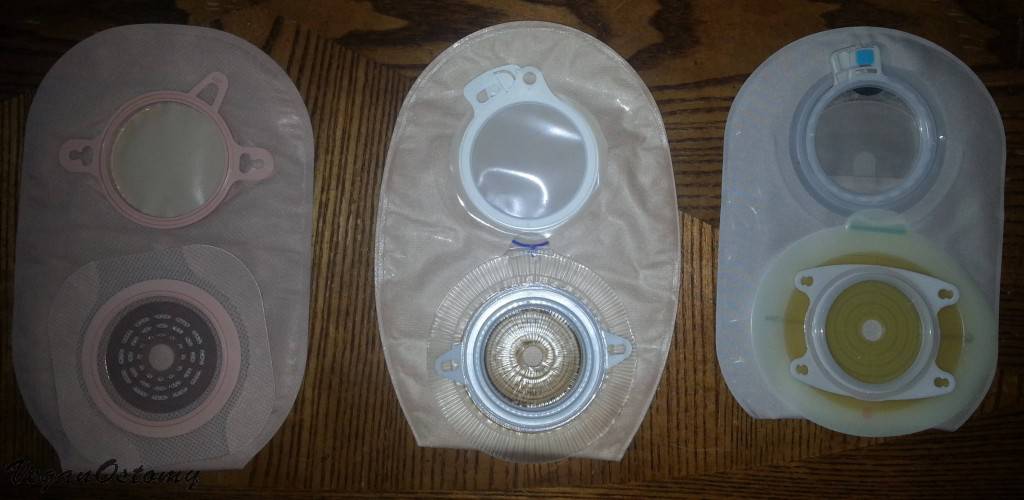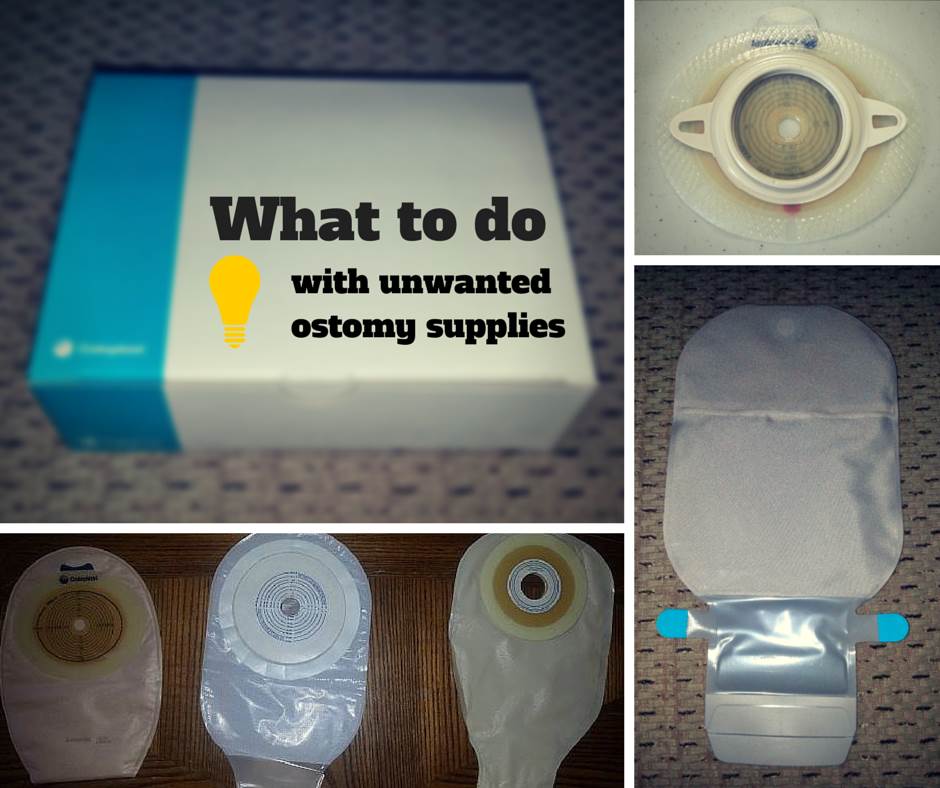Ostomates have a lot of options to choose from when it comes to pouching systems, but it’s not always clear what the advantages and disadvantages are between a one-piece or a two-piece system. I hope that you’ll be able to learn the differences in the following post.
Table of Contents
Video
By playing the above video you agree to YouTube's Terms and Conditions and Privacy Policy
One-Piece Ostomy Systems
This is probably the ostomy system you’ll leave the hospital with. A one-piece means that the wafer (the part that sticks to your skin) is fused to your pouch right of the box. You can’t separate the pouch from the wafer.
Advantages of a one-piece appliance
- Lower profile vs most two-piece systems.
- Usually costs less than two-piece systems.
- Fewer supplies to manage.
- Some people find them more comfortable, especially if they have a less-than-perfect tummy or a hernia.
- Zero chance of your bag falling off (but the wafer still can!).
- Takes up less storage space, especially in a travel bag.
- Less time to make an appliance change.
With a one-piece, the goal is simplicity. Some people love the minimal aspect of a one-piece, but there are some disadvantages too, assuming they are things that you find lacking.
Disadvantages of a one-piece appliance
- Higher chance of getting an imperfect fit.
- No option to rotate your pouch at will (an advantage if you use a Stealth Belt).
- Can be more difficult to apply.
- If you have to change the wafer early, you end up having to throw away the pouch, too.
- If you have a problem with the pouch portion, you have to change the wafer, too.
- No option to change to a different size/style pouch to accommodate different activities.
- Can’t use pouch liners.
- Can’t easily “burp” your pouch to get rid of excess gas.
- Changing closed, one-piece pouches often can lead to skin irritation.
So while you have simplicity, you also lack some flexibility in options. In my experience, one-piece appliances are comfortable, but I always feel that I’m not getting a perfect fit around my stoma in the same way that I can with a two-piece, especially with seeing and/or correcting a gap that might be between my stoma and the cut-out in the wafer.
Two-Piece Ostomy Systems
With a two-piece, you have a separate wafer and pouch. You have an option of sticking the wafer to your skin before applying a pouch, which means that you can have a better look at your stoma and that usually results in achieving a better fit. There are several types of two-piece systems, and each manufacturer has their own coupling method. Here are the most common types:
Adhesive coupling
Like a hybrid of the two different ostomy systems, an adhesive coupling offers you some advantages of having a two-piece, but with the low profile and the added comfort of a one piece. This is done by replacing a hard plastic coupling with an adhesive coupling, which you stick onto a designated spot on your wafer. While some manufacturers say that you can remove the pouch and reapply/adjust it, many ostomates find that doing that is just asking for a leak.
Leaks are a big disadvantage with adhesive coupling systems. If you don’t stick the pouch perfectly onto the wafer, you’ll get a leak between your pouch and wafer. For that reason, I don’t suggest this type of coupling system to anyone who has dexterity, mobility or vision problems.
Some ostomates will stick the pouch to the wafer before applying the wafer to their skin. This effectively means that you are using it as a one-piece.
Mechanical coupling (with lock)
This is an option that Coloplast has perfected, and it’s a huge part of the Click line of products they offer.
This system allows you to mechanically snap your pouch to your wafer and then lock it in place.
The beauty of this coupling is that it allows you to lock and unlock your pouch whenever you like, which is handy for rotating your pouch at will (like when using a Stealth Belt).
I feel completely secure when using a locking coupling, and if you have a high-output stoma which has resulted in your pouch falling off in the past, then this is a system you might want to try.
If you have dexterity or mobility problems in your hands, especially joint pains, then you might find the locking mechanism to be difficult to use.
I’ve read stories on forums where this has been an issue.
Another advantage that I’ve noticed when using 2pc systems with mechanical couplings is that it offers some basic level of protection against impact since the coupling is raised a bit.
If your stoma is flush or slightly protruded, then this might be a good alternative to stoma guards (again, for very basic protection).
Mechanical coupling (snap-in)

This type of two-piece has a simple system that allows your pouch to snap into place on the wafer. This is common on Hollister products and works well. There is a small chance of your pouch falling off or leaking if it’s full and you’re doing a lot of running or jumping, but using a support belt or ostomy wrap will add an additional level of security to help prevent those issues.
One thing that I’ve found with snap-in couplings is that you can’t easily rotate them. You have to take your pouch off, rotate, then snap it back into place. While that sounds easy enough, I find that it only creates an opportunity for leaks.
Tip: I’ve found an easy way to help rotate these stubborn 2pc systems. Check it out HERE.
As I mentioned in the section above, this style of mechanical coupling may also give a basic level of stoma protection.
Advantages of a two-piece appliance
- Allows for rotation of the pouch (some two-pieces).
- Some mechanical coupling 2pc systems are easy to “burp” when gas builds up.
- Can make it easier to get a perfect fit around your stoma (allows visual confirmation that the wafer was cut properly).
- Allows you to replace your pouch without having to change your wafer.
- In the case of an ileoscopy (scoped through the stoma), you likely won’t need to remove your wafer and can simply remove your pouch.
- Allows you to swap between different pouches (that are compatible with your wafer); great if you use a high-capacity pouch at night and a smaller one during the day.
- Can be used with disposable pouch liners.
- Two-piece systems with mechanical couplings may offer some level of protection against stoma impact.
- If you’re a colostomate, and you irrigate your colon, using a two-piece system allows you to easily remove your primary bag and swap it with an irrigation sleeve, then replace it when you’re done – all without having to remove your wafer.
Disadvantages of a two-piece appliance
- Mechanical couplings add stiffness and bulk to the pouch; locking couplings are even more obtrusive
- more expensive to purchase a separate wafer and pouch vs. a one-piece
- some bags can detach or leak from the coupling
- mechanical couplings are not ideal for hernias
Closing Thoughts
So which option is better for you? That’s probably something you’ll need to investigate yourself by sampling products from various manufacturers.
You may even decide to switch between systems, depending on your plans for that week or month.
Question: Are you a fan of one-piece or two-piece ostomy systems? Why/why not?








Hollister also provides a 2 piece wafer called CeraPlus that is a lifesaver for sensitive skin like mine that is allergic to adhesive!! The wafer has ceramides (like those found in beauty products) to help heal and protect the skin. I don’t know what I would have done without it!
So far there is no one piece system from Hollister that does not use an adhesive wafer (or so I was told in November 2022 after my ileostomy).
Hi I use colaplast one peace . . I do get leaks. I use barrier rings. Just wondered if 2 peace would help . Can you use a equaliser on 1 peace.
Hi Vivienne,
I’m not sure if switching from a 1pc to a 2pc will solve your leaks, so I would still explore other causes. But you might simply prefer 2pc appliances, so there’s no harm in sampling them.
If you are referring to the Stomaplex Equalizer product, then I see no reason why it wouldn’t work with the 1pc. I use an empty toilet paper tube to achieve the same results without issues.
Can the Osto-EZ Vent be used with a one piece Coloplast bag/wafer?
@Carol
Hi Carol,
You can use the EZ-vent on a one-piece, provided that you make the hole for your stoma first and there’s enough room to stick your finger into the bag to make the install of the EZ-vent easier. It can be done on the regular Coloplast bags or the Sensura Mio bags.
And Nuffy,Welcome to the forum. Its great to have another voice. We all benefit from all suggestions. We are all dealing with similar but different things and its great to have new new person in the community.
I’ve used the Hollister lock and roll ( velcro like stuff) bags for over four years now. The only kind I have ever used. I have NEVER ever had a leak from that end of the bag. I feel very secure with this system. It doesn’t seem to matter what the consistency of the output is…from liquid to thick.I do make sure the area is ‘clean’ , meaning rinsed or well wiped out after I empty it. If I am not rinsing I just wipe off the end really well. Then I push any remaining stool UP back into the bag as best I can. The whole area to be rolled up should be as free of stool as possible. After that I wipe out all I can reach from the opening, before rolling the whole thing back up.This sounds involved, but I literally do it in my sleep.Note: If you crease the opening BEFORE use ( vertically across the opening) , it makes it much easier to open it wide enough to wipe out later. I think this technique is explained elsewhere on VO.